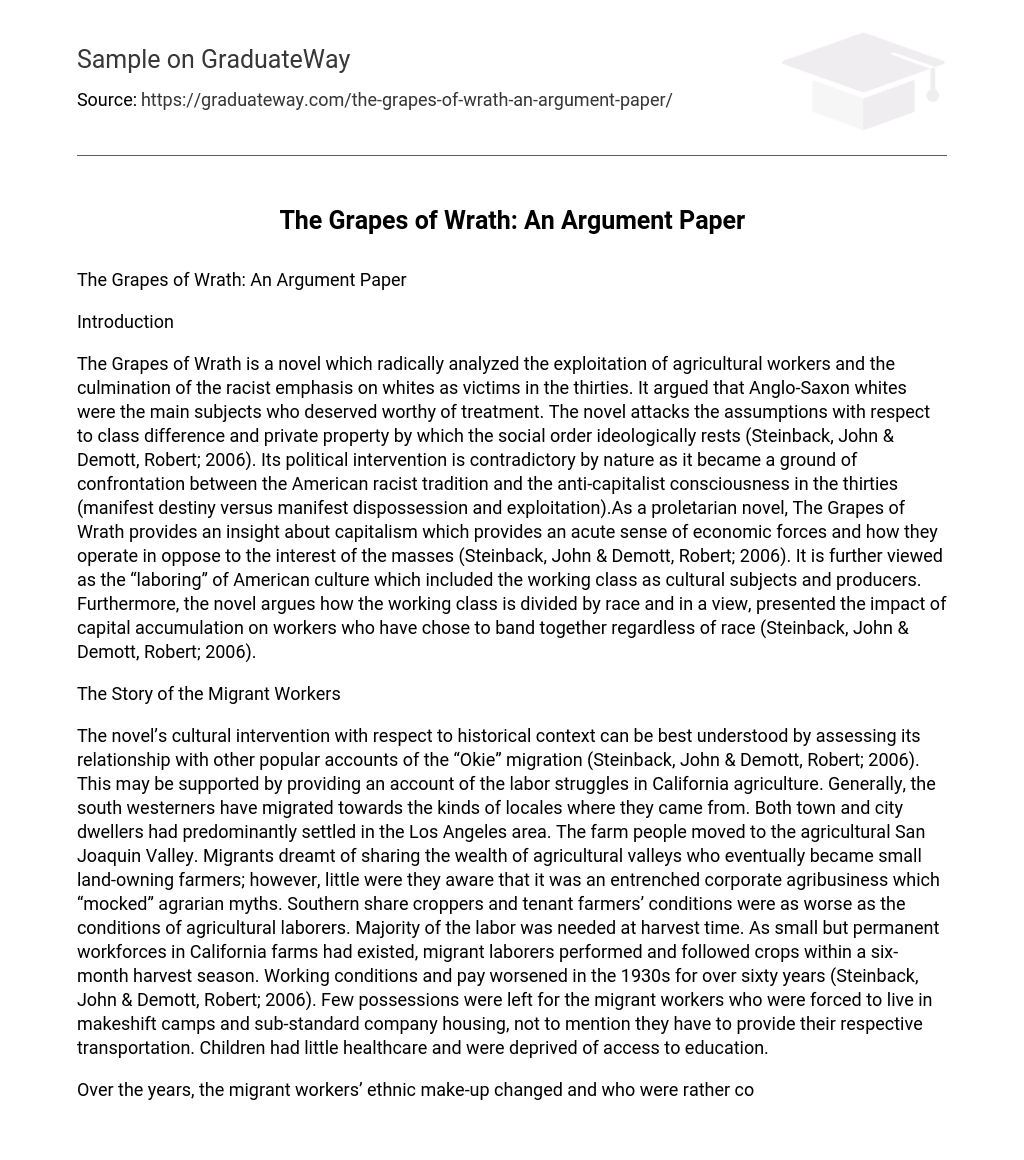Introduction
The Grapes of Wrath is a novel which radically analyzed the exploitation of agricultural workers and the culmination of the racist emphasis on whites as victims in the thirties. It argued that Anglo-Saxon whites were the main subjects who deserved worthy of treatment. The novel attacks the assumptions with respect to class difference and private property by which the social order ideologically rests (Steinback, John & Demott, Robert; 2006). Its political intervention is contradictory by nature as it became a ground of confrontation between the American racist tradition and the anti-capitalist consciousness in the thirties (manifest destiny versus manifest dispossession and exploitation).As a proletarian novel, The Grapes of Wrath provides an insight about capitalism which provides an acute sense of economic forces and how they operate in oppose to the interest of the masses (Steinback, John & Demott, Robert; 2006). It is further viewed as the “laboring” of American culture which included the working class as cultural subjects and producers. Furthermore, the novel argues how the working class is divided by race and in a view, presented the impact of capital accumulation on workers who have chose to band together regardless of race (Steinback, John & Demott, Robert; 2006).
The Story of the Migrant Workers
The novel’s cultural intervention with respect to historical context can be best understood by assessing its relationship with other popular accounts of the “Okie” migration (Steinback, John & Demott, Robert; 2006). This may be supported by providing an account of the labor struggles in California agriculture. Generally, the south westerners have migrated towards the kinds of locales where they came from. Both town and city dwellers had predominantly settled in the Los Angeles area. The farm people moved to the agricultural San Joaquin Valley. Migrants dreamt of sharing the wealth of agricultural valleys who eventually became small land-owning farmers; however, little were they aware that it was an entrenched corporate agribusiness which “mocked” agrarian myths. Southern share croppers and tenant farmers’ conditions were as worse as the conditions of agricultural laborers. Majority of the labor was needed at harvest time. As small but permanent workforces in California farms had existed, migrant laborers performed and followed crops within a six-month harvest season. Working conditions and pay worsened in the 1930s for over sixty years (Steinback, John & Demott, Robert; 2006). Few possessions were left for the migrant workers who were forced to live in makeshift camps and sub-standard company housing, not to mention they have to provide their respective transportation. Children had little healthcare and were deprived of access to education.
Over the years, the migrant workers’ ethnic make-up changed and who were rather considered as minorities than citizens of the United States (Steinback, John & Demott, Robert; 2006). They have become vulnerable to exploitation the fact that they were considered as “aliens”. Anxious about reduced profits, the migrant workers responded with “angry militancy”. Between 1929 and 1934, organizations such as the Communist Party-sponsored Cannery and Agricultural Workers Industrial Union (CAWIU) and the American Federation of Labor (AFL) emerged (Steinback, John & Demott, Robert; 2006). Among the committed unionists were Filipino and Mexican workers. As a result, a state’s sentiment rose to deport Filipino and Mexican workers (between 1931 and 1934, one third of Filipino and Mexican populations in the United States were deported).
Steinback’s Argument
Steinback’s focus on the “dust bowl refugees” is important as it they replaced deported Filipinos and Americans as a rationale for why Anglo-Saxon whites were considered to dominate accounts of the migrant problem (Steinback, John & Demott, Robert; 2006). He claimed that Filipino and Mexican workers came from the “peon” class; that is, they were migrants by nature. On the other hand, the Okies are “Old Americans”, intelligent and resourceful, who experienced how it is to own a land. Moreover, they were descendants who crossed the Middle West and won their land by means of fighting. Rather than birth, they were gypsies by force of circumstances. All of them originated from the Nordic descent: German, English and Scandinavian (Steinback, John & Demott, Robert; 2006). As noted by Steinback, the very reason why their racial lineage is significant is because it shall prevent the growers from abusing them as what they did to the “peons”. The old methods of repression, wages starvation, intimidation and beating are not going to work with this new race; that is, they are considered as American people.
Steinback argued that class exploitation shall be exposed from the confrontation between the white workers and white owners. On the other hand, he also argued the problem’s class nature by implicitly stating that other races are more vulnerable to exploitation relative to the whites. He further claimed that the “peons” were “proved” militant workers who were by far, better unionists compared to the Okies (Steinback, John & Demott, Robert; 2006). Rather than racial inheritance, Steinback referred to a dissent and fighting heritage. He also notes that new migrants have been accustomed to local popular democracies which were based on the “self-containing, old agrarian farm” where there is quite little room for industrial penetration. “When thrust into California agribusiness, they will presumably respond with the independence they are accustomed to” (Steinback, John & Demott, Robert; 2006). At the back of this principle, he still viewed race as a primary agent of the “aimed-for” migrant militancy.
Works Cited
Steinback, John & Demott, Robert (2006); “The Grapes of Wrath”; Penguin Books (464
Pages): Book





